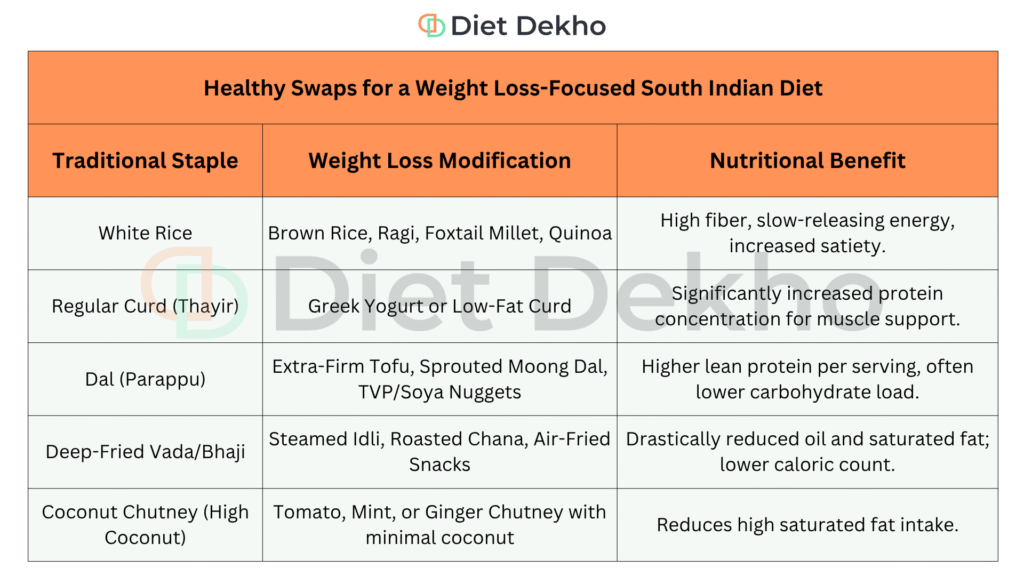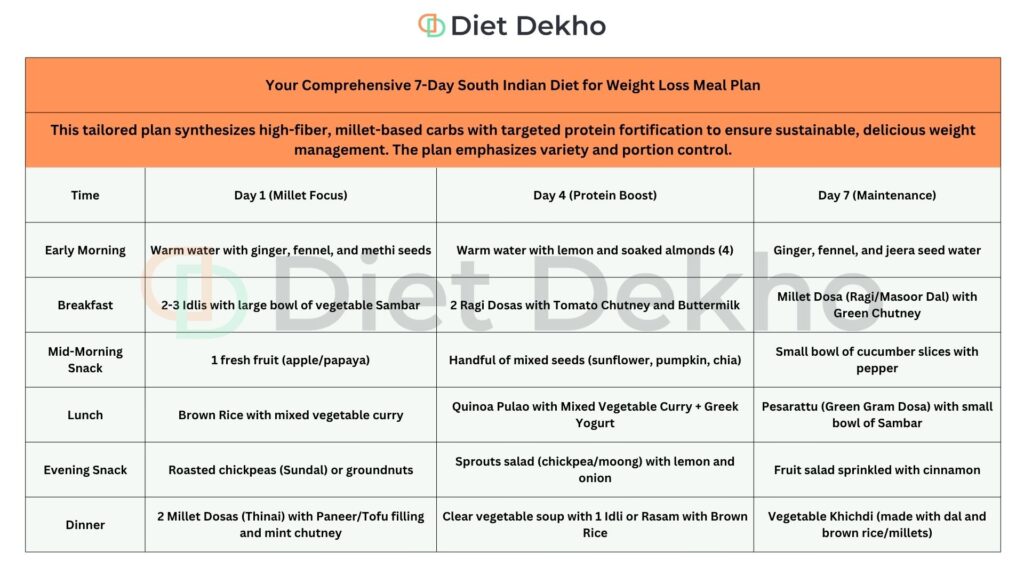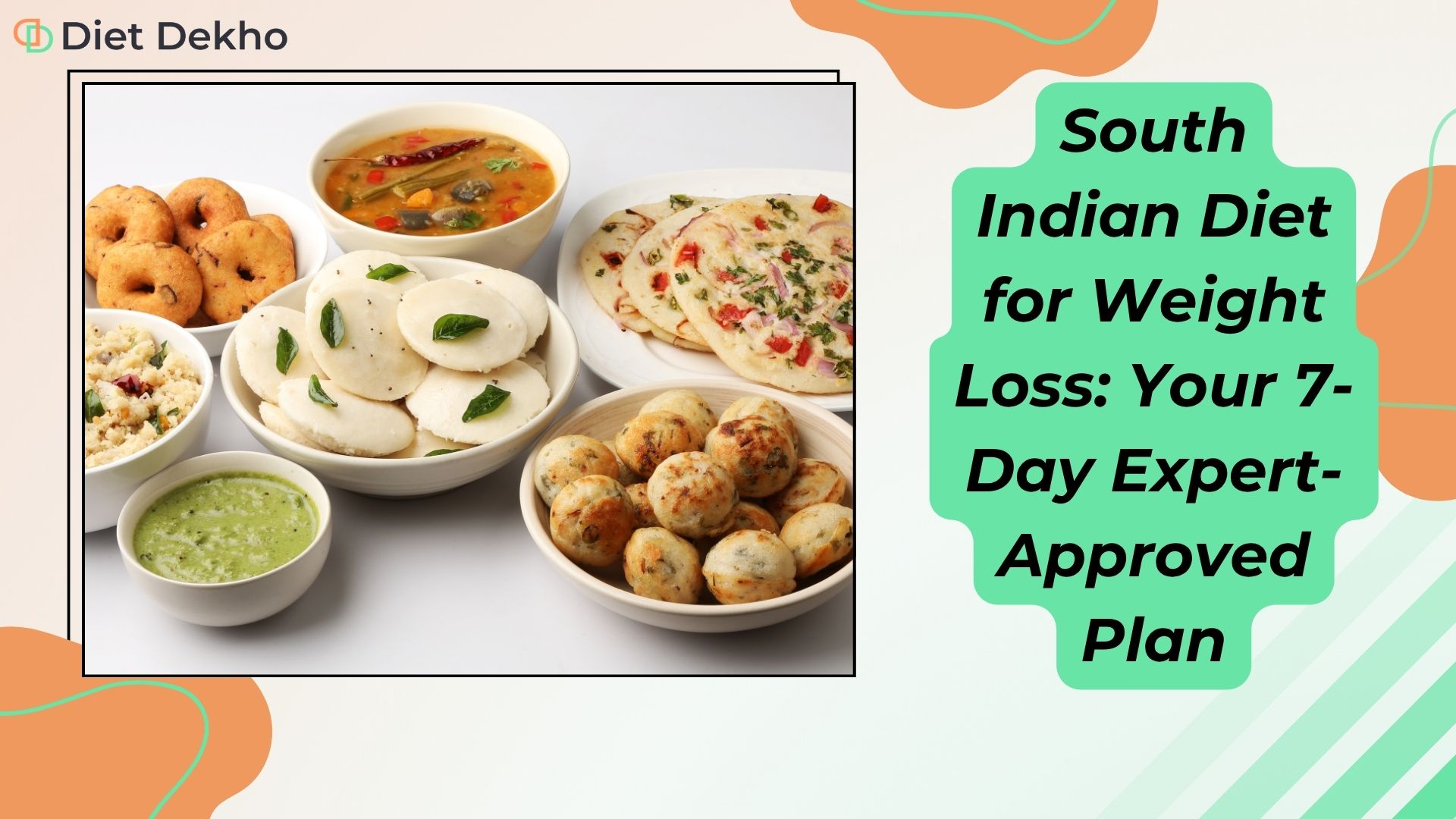The traditional food of South India is a global phenomenon. It offers a powerful blend of flavor, comfort, and inherent nutritional wisdom. For many years, people assumed that focusing on health meant giving up their favorite dishes. However, genuine South Indian cuisine provides a foundation for excellent health and sustainable wellness.
The traditional South Indian Diet for Weight Loss is a remarkably effective tool when optimized for modern life. It naturally features fiber-rich whole grains, gut-friendly fermented foods, and cooking methods that minimize fat. This combination sets the stage for healthy metabolic function and effective management of a higher weight. This comprehensive guide moves beyond simple recommendations. It provides specific, science-backed modifications and a complete 7-day expert plan to help readers achieve their fitness goals without compromising on taste. To build confidence in this approach, consider this fact: steamed staples like one medium idli contain just 39–40 calories, making them inherently low-calorie starters.
The Three Core Pillars of South Indian Weight Management
Successfully utilizing this regional diet for weight management requires understanding the fundamental nutritional elements woven into its traditions. These pillars are based on centuries of farming practices and indigenous cooking techniques.
Millets Over Rice: Maximizing Fiber for Sustained Satiety
One of the greatest strengths of the South Indian food tradition is its variety in grains. Historically, South Indian meals included diverse millets like foxtail, kodo, barnyard, and finger millet (Ragi). These grains are naturally high in fiber. This elevated fiber content is critical because it keeps a person feeling full for longer periods compared to polished white rice.
The goal of sustainable weight loss is maximizing satiety per calorie consumed. High-fiber foods naturally possess a far lower energy density than foods rich in fat. This low energy density allows individuals to consume a greater volume of dishes—such as
Ragi Mudde (finger millet balls) or Thinai Upma (foxtail millet upma)—for fewer overall calories. This volume effect is a powerful mechanism for managing appetite effectively. Studies on dietary fiber consumption confirm that increasing fiber intake improves satiety and overall lipid profile management.
Furthermore, millets are not simply nutrient carriers; they are functional foods. They contain complex phytochemicals, such as proanthocyanidins present in the grain and bran. Research suggests these compounds possess anti-obesity effects by actively promoting feelings of fullness and satiety. The challenge in modern dieting often stems from a preference for easily digestible refined rice over these traditional, slow-releasing millets. By actively swapping white rice with little millets or brown rice, individuals are essentially reversing a modern refinement trend, ensuring they gain nutritional density while naturally restricting caloric intake by limiting hunger. This strategy emphasizes maximum satisfaction from less energy-dense food.

The Fermentation Advantage: Gut Health and Fat Metabolism
Fermented staples, most notably idli and dosa, are essential elements of the South Indian food pattern. These foods are consumed regularly, making them vital and continuous sources of beneficial microorganisms, which are recognized as crucial components of the gut microbiota and overall well-being.
The process of fermentation plays a profound role in metabolism. It generates Short-Chain Fatty Acids (SCFAs). Emerging scientific literature connects these SCFAs to powerful metabolic benefits, including appetite-suppressing effects and improved management of the lipid profile. Fermented foods, like some found globally, may assist in weight management by acting on key metabolic pathways. Specifically, these foods are thought to upregulate fat-burning enzymes, such as carnitine palmitoyl transferase-1 (CPT-1) and uncoupling protein-1 (UCP-1), while simultaneously downregulating mechanisms linked to fat storage, like ACC gene expression.
This regular, traditional practice of consuming fermented foods provides ongoing microbial support. This creates a stable metabolic ecosystem that influences metabolic regulation far more consistently than intermittent supplementation might. Research suggests that a continuous intake of fermented products contributes to better glucose homeostasis and may prevent lipid accumulation. Therefore, preserving these traditional fermentation methods supports both efficient digestion and optimized fat burning. For the best outcome, it is recommended to consume idli and dosa (prepared with minimal oil) often, always pairing them with high-fiber, vegetable-heavy sambar.
Steamed and Sautéed: Low-Fat Cooking Methods
Another inherent advantage of this cuisine is its reliance on steaming and boiling. Many foundational dishes are steamed, such as idli, or boiled, such as rasam, sambar, and certain kootu vegetable preparations. This minimal-fat approach naturally results in low-calorie meals compared to the heavy, cream- and butter-based gravies prevalent in other cuisines. For instance, a portion of idli with tomato chutney can contain roughly 175 calories, and mixed vegetable Upma is about 185 calories.
The approach aligns perfectly with modern nutritional guidelines. The ICMR-National Institute of Nutrition (NIN) strongly advocates for dietary practices that include non-starchy vegetables in every meal, emphasize minimally polished whole grains, and restrict the total daily consumption of cooking oils to 25 grams to 30 grams.
When preparing vegetable dishes like poriyal (dry vegetable preparations), quick sautéing or stir-frying should be prioritized over deep-frying. Quick cooking preserves essential nutrients, such as Vitamin C and folate, which can be destroyed if vegetables are overcooked until they become soft or mushy. While the base dishes provide an excellent low-calorie foundation, success hinges on critically auditing the hidden fats. Deep-fried snacks like Medu Vada or bhaji, along with heavy coconut-rich accompaniments like thick chutneys or avial curries, can quickly sabotage a diet by adding unnecessary calories and saturated fats. The effective strategy is to reduce fat quantity and substitute heavy fats, ensuring the low-calorie foundation of the meal is maintained.

Strategizing Success: Essential Modifications for Fat Burning
For effective fat loss and muscle preservation, the traditional South Indian Diet for Weight Loss requires targeted adjustments, particularly focusing on protein content.
While lentils and legumes are common, the typical South Indian meal can be relatively low in highly concentrated, lean protein, which is vital for building and maintaining muscle mass and for reducing overall hunger during caloric restriction. Protein is the most satiating macronutrient; therefore, increasing its concentration is key to maintaining diet adherence.
Fitness specialists recommend three strategic dietary changes to increase the protein density of traditional meals:
- Lentils to Tofu: Individuals should consider replacing traditional parappu (dal) with extra-firm tofu. Tofu delivers a higher concentration of lean protein per serving compared to standard pulse preparations.
- Curd to Greek Yogurt: Switching regular thayir (curd/yogurt) for Greek yogurt is beneficial. Greek yogurt has a significantly higher protein content, which greatly enhances satiety. Incorporating Greek yogurt or low-fat curds with every meal is a practical way to meet daily protein goals.
- Paneer to Low-Fat Cottage Cheese: When choosing dairy-based protein, opting for low-fat cottage cheese over regular paneer is recommended. This substitution provides concentrated protein with lower saturated fat levels, increasing feelings of fullness.
These modifications are not about abandoning traditional flavors; they represent functional nutrition—a conscious effort to maximize the protein per gram of food consumed. This ensures the individual remains comfortably within a calorie deficit, making the diet sustainable for long-term weight management. Complementary measures include fortifying traditional meals by adding a small amount of moong dal to upma for extra protein, or making Adai (multigrain lentil dosa) using added pulses or sprouts.
The following table summarizes these vital adjustments:

Portion Control Mastery: Sizing Meals for a Calorie Deficit
While choosing healthy foods is important, portion control remains crucial for achieving results. Even high-fiber meals, if consumed excessively, can lead to a caloric surplus.
A visual strategy, often referred to as the “My Plate” concept, is highly effective. Experts advise that half the plate should be filled with vegetables, focusing on non-starchy options like beans, carrots, and peas. For traditionally portioned steamed items like idli or dosa, serving sizes should be limited to 2 to 4 pieces for a typical breakfast.
Prioritizing volume through water-based, fiber-rich items dramatically lowers the calorie density of the overall meal. For example, always serving Sambar or Rasam in generous bowls while minimizing the portion of the primary carbohydrate (rice or millet) achieves this goal. This high vegetable volume not only boosts micronutrient intake but also increases the physical bulk of the meal. This signals fullness to the brain without adding many calories. By consciously filling half the plate with non-starchy vegetables and emphasizing high fluid content (rasam/sambar), the overall meal density drops significantly, supporting the necessary caloric deficit required for weight management.
Harnessing Spice: How South Indian Flavors Boost Metabolism
South Indian cuisine gains its vibrant flavor profiles from the use of various spices. These spices are rich in bioactive compounds that offer a crucial metabolic edge.
Turmeric and Gut Health: A Prebiotic Connection
Spices heavily utilized in South Indian cooking, such as turmeric and cinnamon, contain powerful plant compounds known as polyphenols. These polyphenols act as prebiotics—non-digestible components that nourish beneficial gut bacteria.
The scientific literature indicates that polyphenolic prebiotics are metabolized by microbes in the lower intestine, including Bacteroides and Bifidobacterium. Turmeric, famous for its active compound Curcumin, is widely recognized for its anti-inflammatory properties. This supports digestive efficiency and overall health.
Beyond digestion, turmeric may actively support metabolic processes. It can aid in thermogenesis—the body’s process of burning calories to generate heat—potentially enhancing fat breakdown and preventing the accumulation of fat stores. The consistent inclusion of these powerful phytochemicals helps cultivate a gut environment conducive to leanness and health. This is a form of proactive metabolic management that contributes to overall well-being. For maximum benefit, turmeric should be used regularly in curries,
rasam, and buttermilk. Adding a pinch of black pepper helps enhance the body’s absorption of Curcumin. The fact that chronic inflammation is often linked to higher weight makes turmeric’s anti-inflammatory and microbiome-modulating actions particularly effective for promoting a healthy internal environment.
Ginger, Fenugreek, and the Thermogenic Effect
Appetite control is paramount when trying to maintain a caloric deficit. Ginger, a ubiquitous spice in South Indian tempering, shows significant promise in regulating appetite. Studies suggest that consuming ginger may enhance thermogenesis (calorie expenditure) and reduce feelings of hunger. Furthermore, research has indicated that ginger consumption reduced Orexin, a peptide that stimulates appetite, suggesting a direct role in appetite regulation.
Another key spice is fenugreek (methi). Fenugreek is a common tempering spice known for its ability to improve insulin management. Since continuous insulin spikes—often caused by high carbohydrate intake—inhibit the body’s ability to enter a fat-burning state, managing insulin sensitivity is crucial for weight management. A combination of spices, including fenugreek, turmeric, cinnamon ( dalchini), fennel (saunf), and carom seeds (ajwain), is known to help accelerate metabolism, improve insulin response, and promote better digestion.
For a simple metabolic boost, starting the day with warm water infused with ginger, fennel, and fenugreek seeds is recommended. The regular inclusion of these spices means that the regional cuisine utilizes potent bio-regulators that naturally support the physiological demands of a weight loss journey. The long-standing wisdom of this traditional diet is supported by modern understanding of metabolic health.
The importance of following healthy dietary guidelines, especially those focusing on fiber and vegetable intake, is endorsed by national authorities. The ICMR-NIN states that adopting their recommendations, combined with regular physical activity, holds the potential to reduce the risk of non-communicable diseases such as diabetes and heart attack.
External Link 1 (ICMR-NIN): https://www.nin.res.in/
Designing Your Plate: Low-Calorie South Indian Meals and Snacks
Implementing a successful diet requires practical, easy-to-prepare recipes focused on maximizing protein and fiber while managing calories.
Quick and Healthy Breakfast Choices (Under 250 Calories)
Breakfast serves as the metabolic starting signal for the day. It should prioritize steamed or complex carbohydrate options to ensure steady energy release.
A classic choice is two to three steamed idlis paired with a generous bowl of vegetable Sambar.
Sambar provides high fiber from vegetables and protein from lentils. This combination offers approximately 200–250 calories. It is important to ensure the chutney accompaniment uses minimal or no coconut to keep the fat content low.
Alternatively, Upma made with cracked wheat, sama rice (barnyard millet), or thinai (foxtail millet) is highly recommended. These millet-based options should be loaded with bright vegetables like carrots, peas, and beans, and seasoned with metabolism-boosting ingredients like curry leaves and mustard seeds. For those seeking an immediate protein boost,
Moong Dal Cheela (a lentil crepe) is an excellent, protein-rich alternative.
For readers interested in expanding their knowledge of traditional, healthy ingredients, related articles provide excellent resources.
https://dietdekho.com/high-fiber-indian-foods
Protein-Rich Lunch Ideas Beyond Basic Dal
Lunch must be balanced to prevent the post-meal energy crash and subsequent unplanned snacking. The core goal is to maintain a lower overall glycemic load, which prevents rapid insulin spikes and supports continuous fat burning.
The foundation of lunch should be a complex grain. Using brown rice or quinoa is highly effective. Meals such as Quinoa pulao with mixed vegetables or brown rice paired with spinach dal are excellent choices. For added satiety, Adai (mixed lentil dosa) or Pesarattu (green gram dosa) delivers both complex carbohydrates and concentrated lentil protein. Serving these with a side of Greek yogurt provides an immediate protein boost.
Vegetarians aiming for muscle building can significantly increase the protein density of traditional dishes by adding soya nuggets (TVP) or extra-firm tofu to curries like Kootu or vegetable Saagu. Pairing high-fiber grains with high protein effectively slows digestion, optimizing metabolic function.
Smart Snacking: From Sundal to Fruit Salad
Mindful snacking prevents overconsumption at meal times. It is crucial to strictly avoid deep-fried street snacks like bhaji or samosa.
Nutrient-dense options are best. Roasted chickpeas or groundnuts, often prepared as Sundal, are excellent, satisfying sources of fiber and plant protein. A bowl of fruit salad, prioritizing water-based, fiber-rich options like watermelon, muskmelon, and apples, paired with a small amount of Greek yogurt, makes for a perfect afternoon treat. As an alternative, diluted buttermilk (chaas) serves as an excellent mid-morning or afternoon electrolyte replenisher while providing protein and calcium.

Day 1–3: Resetting Your System with Steaming and Fiber
The initial days focus on establishing a strong foundation using inherently low-calorie and gut-soothing preparations. This period leverages the natural low-fat and high-fiber characteristics of traditional South Indian preparations. Excellent choices include vegetable Upma (made with cracked wheat or semolina, heavily loaded with vegetables) or Poha for breakfast. Lunch should balance brown rice with lentil-rich sambhar and a high-fiber, dry vegetable curry (poriyal). Dinner remains light, perhaps focusing on a crispy Dosa made with minimal oil, accompanied by vegetable sambar. The emphasis here is on effortless calorie deficit and establishing baseline portion control.
Day 4–7: Building Muscle with Millets and High-Protein Focus
The latter half of the week shifts focus to maximizing protein and key micronutrients through strategic swaps. This includes active integration of Ragi dosa or millet pongal. Finger Millet (Ragi) is particularly valued as a rich vegetarian source of Calcium. Protein maximization is achieved through meals like Moong Dal Cheela and Quinoa Pulao. Dinner focuses on protein and complex carbs, such as brown rice or bajra roti paired with a legume-heavy dish like Rajma (kidney beans) or Lobia (black-eyed peas) curry.
The rationale for this protein focus is supported by experts in the field. As online fitness coach Kagivan Prabaharan states, “A high-protein diet can help with weight management by reducing hunger and increasing satiety”. These adjustments ensure the body receives adequate building blocks while operating in a caloric deficit.
Avoiding Common Diet Saboteurs in South Indian Cuisine
Achieving successful and sustained weight management requires an awareness of seemingly healthy dishes that can contain hidden calories.
The Danger of Deep-Frying and Excessive Coconut Use
The cultural love for fried food often undermines the health benefits of the base diet. While steamed idli is commendable, its deep-fried counterpart, Medu Vada, absorbs significant quantities of oil, completely negating the low-calorie benefit. Similarly, adding excessive oil or ghee early in the cooking process unnecessarily increases fat content and can reduce the potency of antioxidants in spices.
Concentrated fats must be restricted during active weight loss. Coconut and coconut-rich curries like Avial are listed among high-fat foods that should be consumed in moderation or avoided. The issue is not the ingredient itself, but its frequency and volume in the context of caloric restriction.
Recommended swaps include limiting or completely replacing deep-fried snacks (bhaji, vada). High-coconut chutneys should be swapped for lighter tomato, mint, or ginger chutneys. When cooking, adhering to the ICMR-NIN recommendation of 25–30 grams of oil per day is necessary. Chefs also suggest adding some fat toward the end of cooking rather than at the very start, which helps lock in both flavor and nutrition.
Hidden Sugars and Starch: Identifying High-GI Vegetables
While the focus should be on vegetables, certain starchy root vegetables, though natural, have a high glycemic index (GI). These can spike blood sugar levels quickly and should be consumed sparingly during active weight management. Examples of vegetables to moderate include potatoes, sweet potatoes, tapioca (cassava), and raw banana. These ingredients quickly provide calories and can hinder insulin management goals, particularly if the individual is prone to insulin resistance.
Instead, the diet should emphasize high-volume, non-starchy options. These include cabbage, carrots, beans, peas, cucumber, and green leafy vegetables. The ICMR-NIN guidelines recommend incorporating non-starchy fresh vegetables and green leafy vegetables into every meal. For further comprehensive guidance on how healthy eating patterns support metabolic health, reputable resources like the Indian Dietetic Association (IDA) can be consulted.
External Link 2 (IDA): https://idaindia.com/
Take the Next Step on Your Wellness Journey
The traditional South Indian Diet for Weight Loss is a testament to the power of ancient wisdom in modern nutrition. Its effectiveness stems from leveraging high-fiber millets, utilizing gut-supportive fermentation, and maximizing metabolism-boosting spices like turmeric and ginger.
Success in using this diet for weight management requires making deliberate modern modifications. This includes prioritizing protein swaps—such as Greek yogurt for curd and tofu for low-concentration dal—and actively restricting hidden fats found in excessive oil, deep-fried snacks, and heavy coconut preparations. By embracing the natural purity of simple, steamed cooking and the dense nutrition of millets, one can honor cultural heritage while achieving optimal, sustainable health and fitness.
Ready to master your health using the delicious, vibrant flavors of South India? Download our comprehensive e-book, “The Ultimate South Indian Weight Loss Cookbook,” which includes 50 high-protein, low-calorie recipes perfectly tailored to the 7-day plan you just read.

